Volume 9 Number 1
©The Author(s) 2007
The Hospital Project
Abstract
This article describes an investigation of medical facilities undertaken by 3-, 4-, and 5-year-old children in a dual-language prekindergarten program in Chicago, Illinois. The article describes the phases of the project and documents the children’s involvement in the project through anecdotal reports, photographs, and samples of the children’s work. The article also indicates the Illinois Early Learning Standards and Benchmarks for 3- to 4-year-olds that were addressed through project work. Teacher’s reflections conclude the article.
Background Information
Darwin Elementary School is located in the Logan Square neighborhood on the northwest side of Chicago. Its prekindergarten through eighth-grade student population of 815 is approximately 83% Hispanic, 13% African American, and 4% White. The majority of families qualify for free or reduced lunches (96%). Thirty-six percent of the children are limited English proficient and receive Spanish bilingual instruction. Darwin offers an English-Spanish dual-language program from prekindergarten through eighth grade, Italian and Spanish as second languages, and a special education inclusion program.
The prekindergarten dual-language program comprised two half-day prekindergarten classes. At the time that this project was undertaken, the program included children with and without special needs. Individualized Education Plans (IEPs) had been developed for the children with special needs. The IEP specifies additional instructional services for children who have a variety of cognitive and speech delays. There were two teachers—one for regular education and one for special education—and one teacher assistant. Each class had 18 children; 6 of the children in each class had special needs. There were 2 African American children, and the rest were Hispanic. All of the children participated and contributed to our work on the Hospital Project. Since there were two teachers in the classroom and one spoke Spanish, we had an ideal dual-language program. Students were exposed to both languages—English and Spanish—at all times, but formal instruction was in Spanish on Mondays and Wednesdays, in English on Tuesdays and Thursdays, and in both languages on Fridays. Students were asked to speak in English when they addressed the English-speaking teacher and in Spanish when they addressed the Spanish-speaking teacher.
In 2004-2005, I participated in the Early Childhood Connections Project sponsored by the Chicago Public Schools and the Kohl Children’s Museum. This project provided training and support to selected preschool and kindergarten teachers to help them learn to implement the Project Approach in their classrooms. Dr. Judy Harris Helm led the training between October 2004 and April 2005. The Hospital Project was the first experience with the Project Approach for the teachers and children who participated.
Phase 1: Emerging Project and Preliminary Planning
The project began with a discussion about health. At this point, the theme was about the human body, nutrition, and exercise. The children made drawings in their journals that represented their knowledge related to body parts. We also created a display of books about a variety of topics related to health.
Children began playing doctor. I borrowed an anatomy model from a science teacher to show children the internal organs and parts of the body. I was not sure how the children would respond to the model, and I was elated to see the excitement generated by the model. Suddenly, I was conducting an anatomy lesson for preschoolers, and all of them were listening attentively. I placed the model in the dramatic play area so that the children could manipulate the different organs and body parts. We also placed a doctor’s kit and an anatomical teaching doll—a doll that is used to show children what is inside of our bodies, the internal organs—in the same area. Most of the children wanted to play at that center. We observed the children’s play for several days and noticed that their topics of conversation and journal writings were about doctors and sick people. Some children had colds and had recent experiences with visits to a doctor, adding realism to their play.
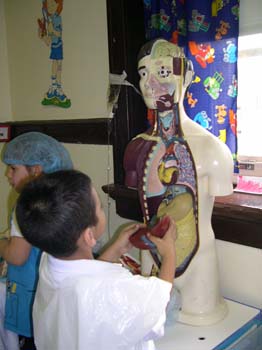
Figure 1. Jonathan manipulating the anatomy model.
Benchmarks 11.A.ECa: Use senses to explore and observe materials and natural phenomena.
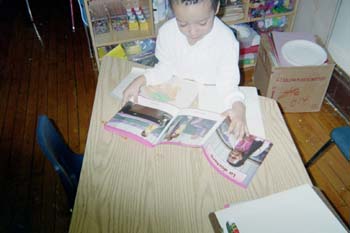
Figure 2. Jacob (4 years old) reading about a visit to a doctor’s office.
Benchmark 2.B.EC: Show independent interest in reading-related activities.
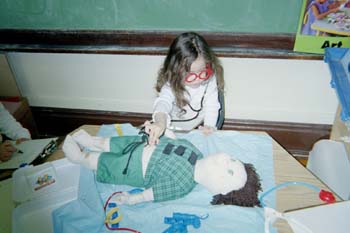
Figure 3. Dr. Karissa (3 years old) examining her patient, the anatomical doll.
Benchmark 4.B.EC: Communicate needs, ideas and thoughts.
While the children were playing doctors, we recorded their conversations. In one case, I asked Karissa what was wrong with her patient, and she said, “The girl is sick; she has pain in her tummy. I think she ate a lot of lollipops. I told her not to eat more candy.”
In another case, I recorded the conversation between Rosa and Ana while they were waiting to see the “doctor”:
Ana: ¿Què tiene tu niña?/ What is wrong with your girl?
Rosa: Está enferma. La llevo a la "dotora." Ella tiene calentura (tocando su frente)/She is sick. I am taking her to the doctor; she is hot (touching her forehead).
Ana: Mi niña comió mucho le duele su panza./My girl ate too much, she has pain in her panza [stomach].
Rosa: Mi mamá dice que cuando estás enferma no puedes comer comida, solo sopa. Yo no le di nada de comer, la tuya no puede comer tampoco./My mother said that when you are sick you couldn’t eat, so I didn’t give her anything to eat, yours shouldn’t eat either.
Ana: No, ella quería comer una "cookie" pero yo no se lo voy a dar. Mira, la "dotora" está allá, ya me voy./No, she wants to eat a cookie, but I won’t give it to her. Look—the doctor is coming; I got to go, goodbye!
The children also wrote in their journals daily. They drew pictures of their own visits to doctors and talked about their experiences during those visits and in the classroom doctor’s office.
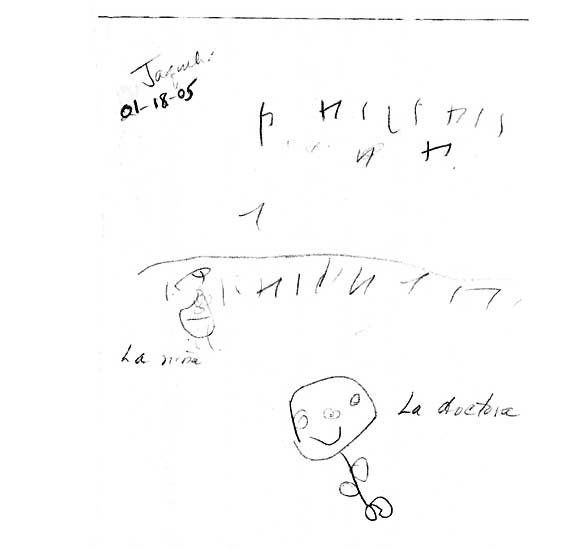
Figure 4. Madeline (4 years old) drew a picture of a doctor.
Benchmark 3.C.EC: Use drawing and writing skills to convey meaning and information.
At this point, I introduced the children to observational drawing—a representational strategy commonly used in the Project Approach in which we look closely at an object, noting all the details and learning all that we can about that object. We then draw a picture of the object. The more knowledge we have of the object, the more detailed the picture will be. I modeled this technique for the children and gave them opportunities to practice using different objects from our classroom. After I demonstrated the process and children practiced with different objects, Alex, a 5-year-old, made an observational drawing of a teddy bear. He also dictated a story about the bear:
Alex: It is a bear. He was dancing; his mother was yelling because she did not want to see him jumping. She did not want him to fall from the bed. His mom punished him. He had to do his homework first. The bear was sad. His mom said that if he falls down, he has to go to the doctor. He did not want to go to the doctor because he gives him shots.
Figures 5 and 6 show the two drawings of the bear. One was done on February 18, 2004, and the other on February 25, 2004, after talking about the bear and describing the bear to the class.
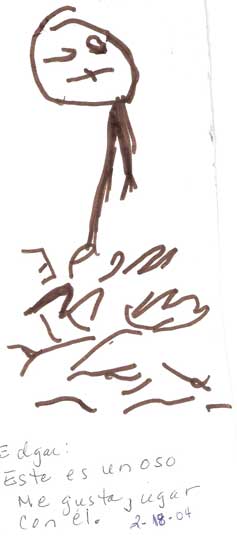
Figure 5. Observational drawing #1 of a teddy bear completed on February 18, 2004. 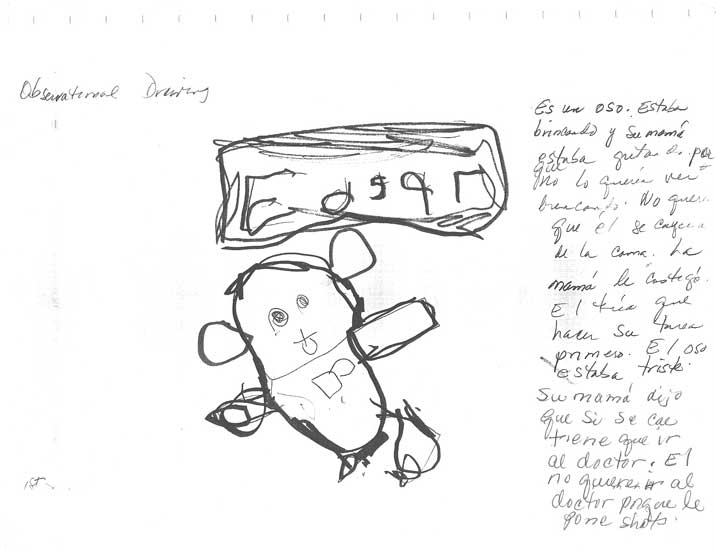
Figure 6. Observational drawing #2 of a teddy bear completed on February 25, 2004.
Benchmark 3.B.EC: Dictate stories and experiences.
Benchmark 25.A.ECd: Visual Arts: Investigate the elements of visual arts.
At that point, I knew that the project should be something related to doctors. I made a preliminary web with possible topics for our project. I looked at the state goals and standards, and the teachers brainstormed different activities that could provide opportunities for hands-on experiences to meet our curriculum goals (Appendix 1).
We had planned to go to the Robert Crown Center for Health Education for a field trip. The Robert Crown Center is a community center that offers health educational programs for preschool-age through high-school-age children. Located in the center is the Lawndale Christian Health Center, a community-based nonprofit organization that provides health care services to the Lawndale and Garfield communities in Chicago. Because we were going to be in the area, I thought that it would be a good idea to take the children to a health care center to investigate more about doctors and what happens in a clinic or health center. I called the health center to arrange a visit, and the manager of the clinic was very helpful. To my surprise, she agreed to allow us to tour the health center, taking a few children at a time. We told children about the field trip, and they were excited.
Before the trip, I sat with small groups of children to assess what they knew about doctors, health care centers, and doctors’ offices, and to discover questions that children had about doctors. I read a book to the children about a child’s visit to a doctor’s office. The following excerpts and documentation were taken from our discussions.
Teacher: ¿Les gusta ir al doctor?/Do you like going to the doctor?”
Emmanuel: Mi mamá me llevó "mañana" al doctor, Estaba enfermo. El doctor miró mi "gaanta", me dolía./My mom took me tomorrowto the doctor; I was sick. The doctor looked at my throat; it hurt.
Sherley: Si, Yo no podía respirar la doctora me dio "medecina."/Yes, I couldn’t breathe. The doctor gave me medicine.
Ana: Yo no quiero ver el doctor. El me pone "shot", duele mucho./I don’t like to see the doctor. He gave me a shot. I don’t like shots; it hurts a lot.
Teacher: Los doctores son nuestros amigos. Ellos solo nos quieren ayudar. Aveces tienen que hacer cosas que no nos gustan pero que son para nuestro bienestar, como son las vacunas. ¿Quieren saber por que los doctores nos ponen vacunas?/Doctors are our friends. They just want to help us. Some time they have to do things we do not like so we can be healthy, like giving us a shot. Do you want to know why doctors give us shots?
Ana: Si.
Teacher: Que más quieren saber?/What else do you want to know?
Emmanuel: Mi doctor me dió stickers y es buena, me miró mis orejas con una cosa. Mi hermano no le gustan las 'shots'. "Madestra", no me gusta estar enfermo. ¿Por què nos enfermamos? ¿Por què los doctores nos dan stickers?/My doctor gave me stickers, and she is nice. She looked at my ears with a thing. My brother do not like when she gave him shots. Madestra [Teacher], I do not like to get sick. Why do we get sick? Why doctors give us stickers?
Ana: Mi dotora me dió stickers tambièn. Me gustan los stickers./My doctor gave stickers too. I like stickers.
Sherley: Muchos doctores me vieron cuando yo estaba en el hospital tenían ropa blanca, algunos tenían ropa azul como mi "dotora," ella se llama doctor Ruiz. Tambièn se pusian guantes en las manos, ¿Para que?/Many doctors came to see me when I was in the hospital. They had blue clothes and gloves in their hands. Why?
Benchmark 1.C.EBc: Respond to simple questions about reading material.
Ana and Sherley went to play with blocks. Jacob joined us. He had heard our discussion.
Jacob: I know—they did not want to get dirty. I went to the hospital with my mommy. I was sick and the doctor used gloves too. She checked my heart with the “Heart Listener” and looked at my mouth and I said aaaaah, so she can look at my throat. She took blood from my arm. It hurt a little. She said I had an infection. The doctor gave a piece of paper to my mom to get me my medicine. My mommy bought me the medicine at the “Medicine Store.”
Rosa joined the group.
Rosa: Mi mamá compró medicina donde compramos la comida. El otro día ella buscaba otra medicina y no la pudo encontrar. Ella le preguntó al hombre de la tienda y èl le dijo que tenía que ir a Osco o a Walgreen (Dos farmacias del lugar)/My mom bought medicine where we bought the food. The other day she was looking for more medicine, and she couldn’t find it. She asked the person in the food store; he said we had to go to Osco or Walgreen (local pharmacies).
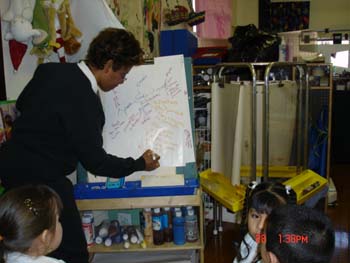
Figure 7. After discovering the children’s interest in health, I completed a topic web with the children to determine how much they knew about health.
Benchmark 4.A.EC: Listen with understanding and respond to directions and conversations.
Benchmark 5.B.EC: Relate prior knowledge to new information.

Figure 8. Emmanuel, Ana, and Sherley having a discussion about doctors.
I continued to meet with small groups of children, listening for interests, knowledge, vocabulary, and questions they might have. Not all of the children were at the same level of understanding and maturity. Some children were not able to say much about their own experiences with doctors. They liked to play doctors, but their conversations were minimal at this point. I wanted to know how this project would help these children.
After several days working with different groups of children, we develop a KWL chart (what we Know, what we Want to know, and what we Learned).
The children discussed what they knew about doctors:
- Children knew that when they are sick, they need to see a doctor.
- Doctors work in a clinic or hospital.
- Doctors wear white clothes and gloves.
- Doctors give medicine.
- Doctors give shots.
- They give stickers.
- They use tools to check the people.
The children also discussed what they wanted to know:
- How to prevent sickness
- Name of the tools doctors use
- Places doctors work
- People who take care of us when we are sick
- Why doctors give us shots
- Why they wear white clothes and gloves
- Why they give stickers
- Do doctors get sick? Where do they go when they are sick?
Benchmark 13.B.ECa: Express wonder and ask questions about their world.
My Concerns
Because I was new to the Project Approach, I had many questions about this approach to learning. Am I leading the children in the right direction? Am I missing something? Is this the right topic for a project? Are my children going to learn something from it? Am I going to be able to address the state’s goals and benchmarks through the project? I knew at this point that the children were showing a lot of interest in the topic. Teachers were getting as excited as our children about this project. I liked the children’s motivation and interest. I believe that when children are motivated there are no limitations to what they can do. At this point in the project, I was not sure which direction the project would take. I knew the project was going to be related to doctors. I waited to see what would happen when we visited the clinic. There were so many aspects of the clinic that they could see such as doctors, nurses, the laboratory, the X-ray department, equipment, tools that doctors use, etc. I was curious about which of those would be most interesting to the children.
Phase 2: Developing the Project
To get ready for fieldwork, my assistant and I gathered and read books to the children about doctors and sickness, and had several discussions with the children in small groups.
Benchmark 1.C.ECa: Retell information from a story.
Children began reading health-related books and had discussions about what happens when they get sick, who takes care of them when they are sick, and what happens in a doctor’s office. We also made an anticipatory web with the children.
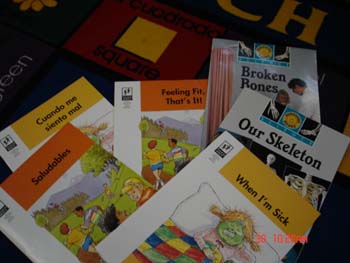
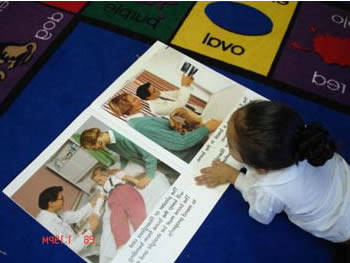
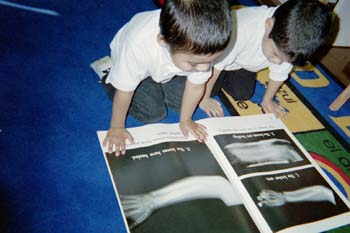
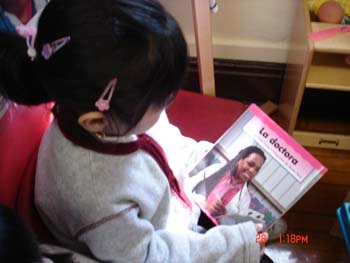
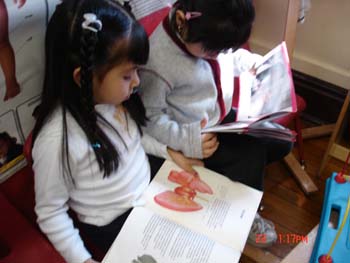 Figure 9-13. The children read books related to health.
Figure 9-13. The children read books related to health.
Benchmark 2.B.EC: Show independent interest in reading-related activities.
Benchmark 5.A.EC: Seek answers to questions through active exploration.
Benchmark 31.A.ECb: Exhibit eagerness and curiosity as a learner.
Benchmark 1.A.Eca: Understand that pictures and symbols have meaning and that print carries a message.

Figure 14. The anticipatory web we made with the children.
Field Site Visit
We took the children to the Robert Crown Center for Health Education to learn more about how to be healthy. We had also made arrangements to visit the health care clinic located at the center. We wanted the children to see how a health center functioned. The manager of the clinic gave us a tour of the clinic. Children had the opportunity to visit the clinic as visitors and not as patients. Some children were a little apprehensive because they could not understand that we were visiting the center, not going to the doctors for medical care.
Most of the children interacted with the doctors and nurses in the center. Some parents visited the center with us. The children were excited to see the laboratory, where some patients were having a blood test. The laboratory experience made some children fearful, so we reassured them by staying with them at all times and explaining that we were only visiting the clinic to see the different rooms in it. The manager showed us the different examining rooms, the laboratory, X-ray department, and the dentist’s office. The dentist was there and talked briefly to us, explaining the importance of visiting the dentist and having a good check-up. In several instances, the children had the opportunity to talk to the doctors and see some of the tools the doctors use. Some children sat on the examining table; they were very curious about everything that was in the room. Children also had the opportunity to talk to the clinic’s nutritionist. She showed them a tube filled with fat that represented the amount of fat in a small bag of french fries. She recommended eating baked or mashed potatoes that did not have the fat in them. The children enjoyed the visit very much!
We were not allowed to take pictures inside the clinic for legal and confidentiality reasons; however, some children used observational drawing to record their impressions. When we were at the clinic, Jonathan drew the examining table and later sat with us to dictate a story about a time when he went to the doctor and how the doctor examined him (Figure 15):
Jonathan: The doctor checked me with the escopio. He checked my stomach and he checked my mouth with a stick to see if I was well or not. This is the table where I went up for the doctor to check me (Figure 15).
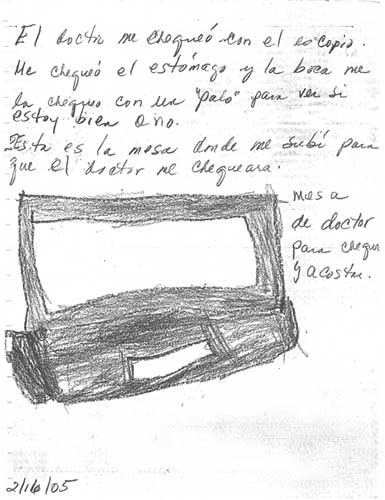
Figure 15. “Doctor’s table to check and lay down” Jonathan (2-16-05).
Benchmark 11.A.ECb: Collect, describe and record information.
After the visit to the doctors’ offices in the health center, children were captivated by the doctors, the different machines, and the tools doctors use. We had several group discussions to review their fieldwork experience. I used the Internet to find pictures related to hospital work. Children were able to identify what the photographs depicted. Children wanted to know more about the different rooms, people, tools, machines, and equipment they had seen.
The center that we had available for children to role-play doctors became too small because they kept adding more elements to their play. I sat with the group to ask if they wanted to expand their play area. They did. In fact, they wanted me to play hospital. We helped brainstorm about hospital resources we might need if they wanted to have a hospital.
The following is the list the children dictated to teachers about what was needed to have a hospital:
- Examining table
- Laboratory
- Pharmacy
- Waiting area
- Receptionist
- Examining room
- Doctors, pharmacist, and nurses
- IV solution
- Bandages
- Cotton
- Different doctors’ tools (Escopios, “stick,” gloves, masks)
- Medicine bottles
- Clipboards
- Papers
- Clothes
- Scale
We talked about how to set up our classroom as a hospital and how we were going to get the resources that we did not have. Some children brought cotton and bandages. I contacted the University of Illinois hospital, where I worked many years ago. They were very cooperative and contributed a sample of intravenous solution, bandages, a table cover, thermometers, operating room shoes and hats, masks, tongue depressors, and a penlight; an orthopedic clinic at the same hospital donated a plaster arm cast. We had a balance scale, some real stethoscopes, and a sphygmomanometer. We bought some doctors’ play kits and costumes. Children designed lab coats using white garbage bags. They finger-painted the bags with handprints. Then we started working on the classroom environment to set up the little hospital.
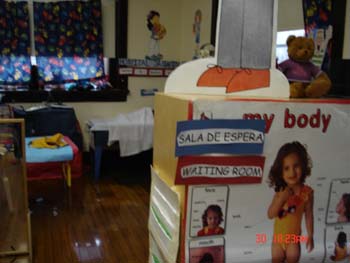
Figure 16. The Darwin Hospital waiting room. 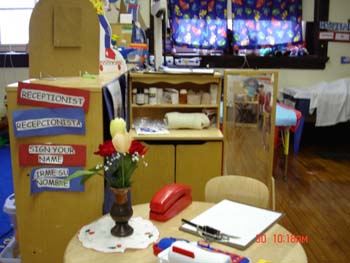
Figure 17. The Darwin Hospital receptionist/nurse station. 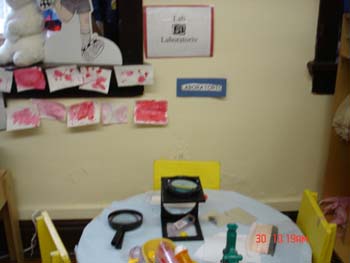
Figure 18. The Darwin Hospital laboratory. 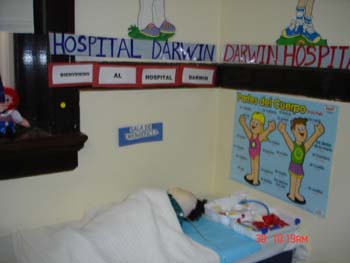
Figure 19. The Darwin Hospital examining room. 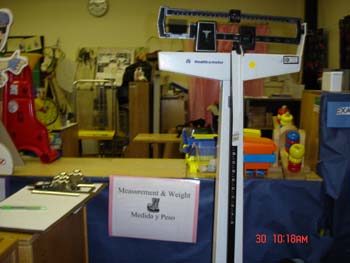
Figure 20. The Darwin Hospital scale. 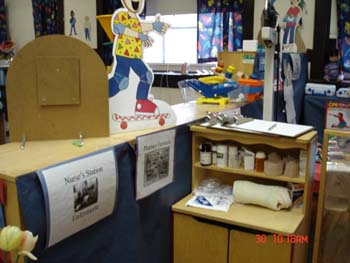
Figure 21. The Darwin Hospital pharmacy.
Visiting Experts
At the end of February, our hospital was completed. We invited experts to come and visit us. We had visits from two pediatricians who brought some tools for the children to look at and to manipulate. The doctors named each tool and described its use. They showed the children how to use the stethoscope and the sphygmomanometer. Children actually used the different tools. We read our list of questions to the doctors. The doctors answered the questions during their presentation. The doctors brought other supplies as well—bandages, tongue depressors, masks, and some stickers. Children were wildly enthusiastic! Children showed the doctors how we set up the little hospital in the classroom: The Darwin Hospital was inaugurated that day.
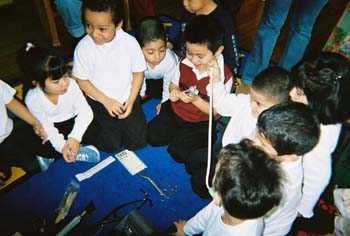
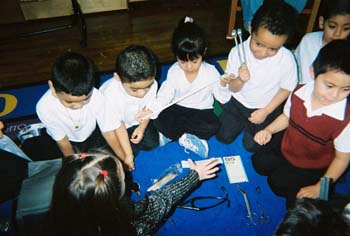
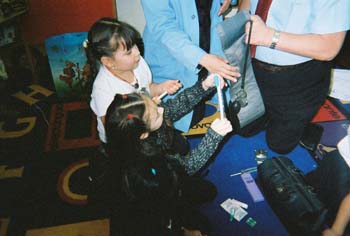 Figures 22-24. The children explored the tools that the doctors brought.
Figures 22-24. The children explored the tools that the doctors brought.
Benchmark 11.A.ECa: Uses senses to explore and observe materials and natural phenomena.
State Goal 11, Learning Standard A: Know and apply the concepts, principles and processes of scientific inquiry.
Benchmark 13.B.ECb: Begin to be aware of technology and how it affects their lives.
The next day, when the children came to school they couldn’t wait to play in the hospital. First, we had a group meeting to discuss what we were about to do, the different areas, and the activities. We talked about the different tools that they were going to use, about the rules, and about how everybody would take turns. I did not have to tell them twice what to do. From that moment, they took over, and everything went smoothly. We did not break our routine—children played hospital at free play as one of the centers. During all of the time that the children played hospital, we observed only cooperative behavior.
Benchmark 19.C.EC: Follow simple safety rules while participating in activities.
Darwin Hospital in Action
At first, students played with the anatomical doll, pretending that she was the patient. They also explored the different tools and materials in the center to figure out their uses and characteristics. Teachers were acting as facilitators, walking around the different centers, guiding the children’s exploration with questions to help them use high-order thinking skills. For example, when they played with the doll, I asked children to recall the different organs that they were able to see in the doll and to see if they were able to understand the organs’ functions. When they were doctors, I asked questions to see whether they remembered the names and uses of doctors’ tools such as the stethoscope and the thermometer. We also asked questions about the roles that they were playing, and we addressed children by their chosen title. When they used a stethoscope on the doll, we asked, “What are you using to check the patient? Why are you using it? What is wrong with the patient? What are you going to do to help him/her? Why?
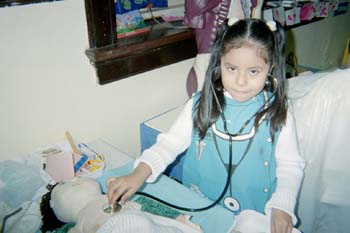
 Figures 25 & 26. The doctors are examining their patient (the anatomical doll).
Figures 25 & 26. The doctors are examining their patient (the anatomical doll).
Waiting Area
In the waiting area, when children wanted to see the doctor, they had to write their name on the sign-in sheets. They were called in order when it was their time to see the doctor. Here are examples of the conversations:
Ana: No llores, el doctor ya viene./Don’t cry—the doctor is coming.
Melanie: ¿Por què llora tu bebè?/Why is your baby crying?
Ana: Le duele la panza./She has tummy pain.
Sherley: Comió muchos dulces./She ate too much candies.
Melanie: Mi bebè la va a "picar" la doctora. No me gusta que me "pique" el doctor, eso duele./My baby is going to get a shot by the doctor. I don’t like that doctor gives me a shot, that hurts.
Ana: Voy con el doctor, adios./I’m going with the doctor, bye.
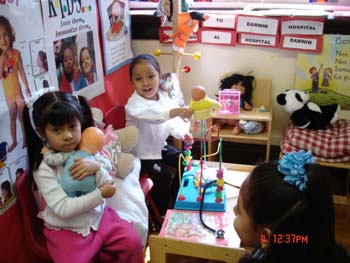
Figure 27. Sherley and Melanie played with their babies. 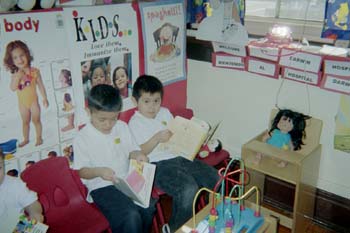
Figure 28. Eliseo and Ricardo (4 years old) are reading while waiting to be seen by the doctor.
Receptionist/Nurse Station
In the receptionist/nurse station, the children took turns playing different roles. Children used a sign-in sheet attached to a clipboard. Some of the children interviewed the patients before they saw the doctor, pretending to write down what the patient said.
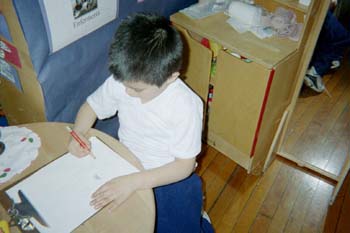
Figure 29. Ricardo writing on the sign-in sheet. 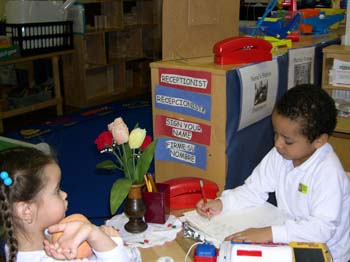
Figure 30. Jacob interviewing Karissa before her visit with the doctor.
Benchmark 3.A.EC: Use scribbles, approximations of letters, or known letters to represent written language.
State Goal 3: Write to communicate for a variety of purposes.
Benchmark 3.C.EC: Use drawing and writing skills to convey meaning and information.
Benchmark 6.A.ECa: Use concepts that include number recognition, counting and one-to-one correspondence.
This conversation took place between Jacob and Karissa while she was waiting to see the doctor:
Jacob: Why did you bring your baby to the doctor?
Karissa: My baby is sick with fever; she was crying hard, and she didn’t eat.
Jacob: The doctor will see her and give her medicine. You need to go to the pharmacy store to buy the medicine. It costs $3.00.
Karissa: Can we see the doctor now?
Jacob: Yes, you need to go there and wait (showing the examining table).
In his journal, Jacob retold the story by looking at the photo in Figure 30. He dictated: “I was a ‘recepeneship.’ When I write, I called somebody so they can go in the hospital. Karissa was there because she needs her check up and her baby was sick. She told me that they needed to see the doctor. I was writing what she said (Figure 31). When I was done writing, I went to play in a different area.”
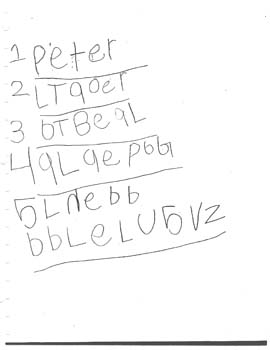
Figure 31. Jacob took these notes while talking with Karissa.
Benchmark 16.A.EC: Recall information about the immediate past.
Marisela pretended to answer patients’ phone calls. She made an appointment for a patient, and she wrote the patient’s name on the sign-in sheet. (Click on Figure 32 to enlarge it so you can see her writing.)

Figure 32. Marisela pretending to answer patients’ phone calls.
Examining Room
All the children participated in the project. Some were more involved than others, but everybody had the opportunity to have an active role. Children took turns being the doctor. They role-played different scenarios, such as bad colds, tummyaches, and earaches. We opened the hospital to the public. We invited staff from the school to come to visit our hospital. When they came, they had the opportunity to visit our specialists, who took their care very seriously.
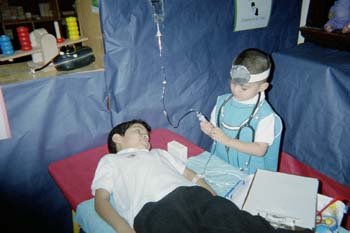
Figure 33. Dr. Alex examining one of his patients. 
Figure 34. Nurse Ana and Doctor Emmanuel getting medicine from the pharmacy.
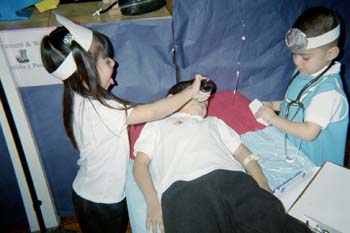
Figure 35. Nurse Ana giving the medicine to the patient, while the doctor checks the intravenous solution. 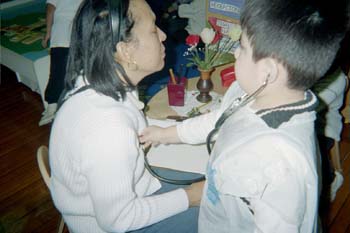
Figure 36. Dr. Emmanuel (4 years old) is checking his patient Mrs. Driver, our librarian. 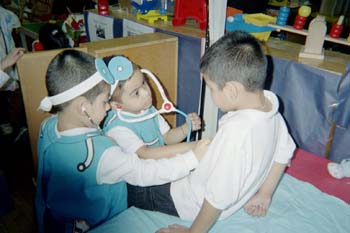
Figure 37. Dr. Jonathan and Dr. Eliah checking a patient's heart. 
Figure 38. Dr. Josiah (3 years old) is checking Mrs. Pagán’s heart. 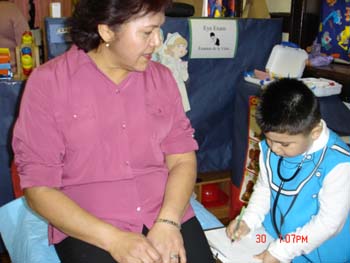
Figure 39. Dr. Emmanuel is writing down some notes while talking with Mrs. Contreras, one of the teachers at our school.
Mrs. Kaufman, the assistant principal, came to see Dr. Jacob. While he was checking her, Dr. Larissa went to the pharmacy to get some medicine. She offered the medicine to Mrs. Kaufman, who said she didn’t like medicine. Dr. Larissa explained to her that she had to take her medicine to get well. Mrs. Kaufman took the medicine. Dr. Larissa was happy that her patient was cooperative (Figures 40-44).
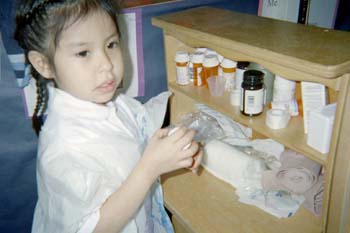
Figure 40. Dr. Larissa looking for medicine for Mrs. Kaufman.
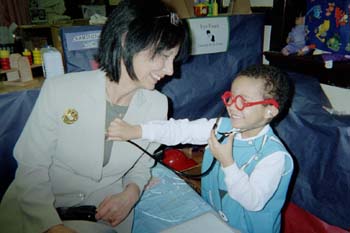
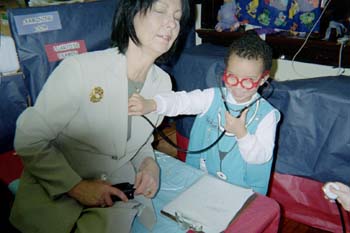 Figures 41 & 42. Dr. Jacob checking Mrs. Kaufman.
Figures 41 & 42. Dr. Jacob checking Mrs. Kaufman. 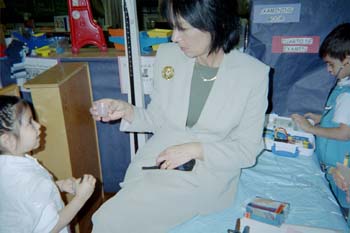
Figure 43. Dr. Larissa offering medicine to a reluctant Mrs. Kaufman. 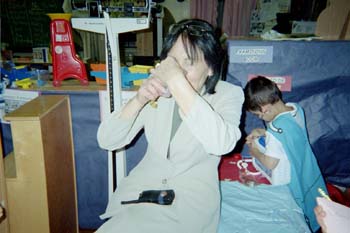
Figure 44. Mrs. Kaufman taking the medicine.
Jacob dictated the following while he looked at the photographs in Figures 40-44:
Jacob: The lady came to see the doctor. She came to see the doctor because she is sick. I listened to her heart with the ‘Sthespio.’ Larissa is looking for the medicine at the pharmacy’s store. She gave the medicine to the lady. The lady didn’t like the medicine, but she took it anyway. She was pretending to be sick.
Cindy, the school’s nurse (who was pregnant), came to visit our doctors. They immediately took her to hospital to check her baby (Figure 45).
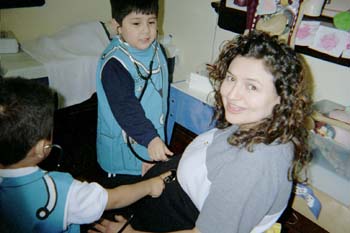
Figure 45. The doctors check nurse Cindy’s baby.
Sarah, our coach, visited our hospital. The doctor gave her instructions about her prescription (Figure 46).
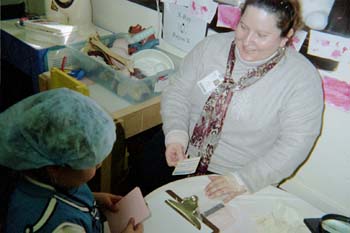
Figure 46. The doctor giving directions about a prescription.
Mr. Ramírez, another teacher from our school, came to see our specialists. Dr. Azucena and Dr. Mariana attended him. He mentioned that when Dr. Azucena checked his mouth, she saw his fillings and said that he needed to clean his mouth because it was dirty. She put a cast on his hands and wrapped him with bandages on his arms and mouth.
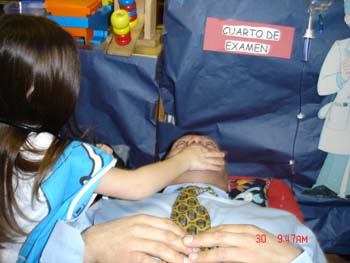
Figure 47. Dr. Azucena checking a patient’s mouth. 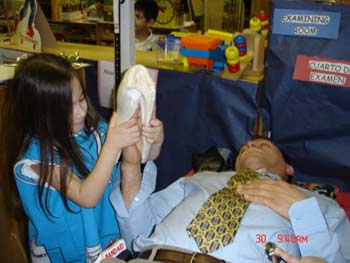
Figure 48. Dr. Azucena putting a cast on a patient’s hand. 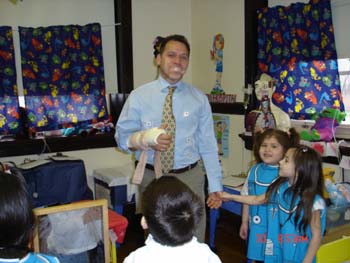 Figure 49. The patient’s mouth and hand were bandaged.
Figure 49. The patient’s mouth and hand were bandaged.
Laboratory
For the laboratory, I gave children red ink, cotton, and index cards. They pretended that the ink was blood. They used the magnifier or a microscope to observe the designs they made with the cotton and the ink. At the lab table, we asked questions such as, “How do you think your design will look through the magnifier or microscope?”
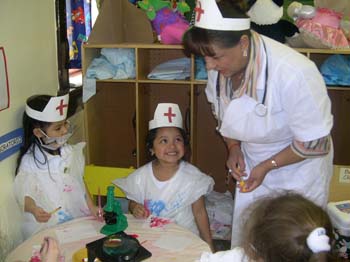
Figure 50. Mrs. Pagán with our lab technicians. 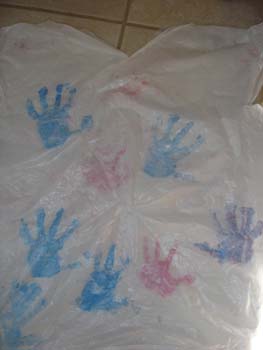
Figure 51. The lab coat that children designed using finger paint. 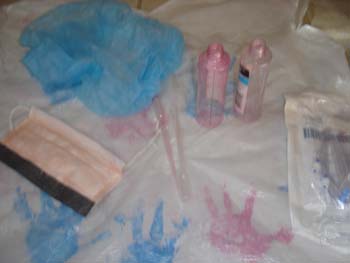
Figure 52. Some of the materials that children used in the lab.
Benchmark 19.A.ECb: Engage in active play using fine motor skills.
Eliah was playing with the ink, pouring the ink solution from one container to another. He then took a cotton swab and started making designs on the index card. Before he placed the card under the magnifier, I asked him to predict what he was going to observe:
Eliah: I made a flower for “mami.”
Teacher: How big is it?
Eliah: It’s little.
Teacher: If you put it under the magnifier, what do you think is going to happen?
Eliah: Nothing.
Eliah (after putting the index card under the magnifier): Teacher, teacher—my flower is a little bigger. Can I put something else?
Teacher: Yes.
He walked away and looked for other objects to see how they looked under the magnifier. He kept playing there for a while and invited his friends to discover what he was observing.
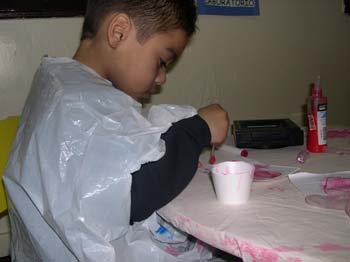
Figure 53. Eliah playing with ink. 
Figure 54. The children making designs on index cards. 
Figure 55. Eliah preparing to look at his design with a magnifier.
State Goal 11: Understand the processes of scientific inquiry and technological design to investigate questions, conduct experiments and solve problems.
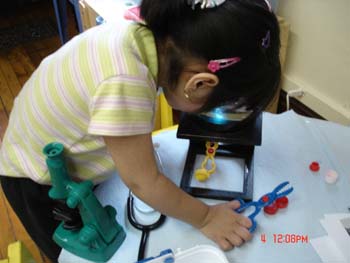
Figure 56. Marisela looking at her design with a magnifier.
Benchmark 11.B.ECa: Use scientific tools such as thermometers, balance scales and magnifying glasses for investigation.
Another lab activity was taking fingerprints. Many of the children had their fingerprints done in the classroom using black ink and an inkpad. After taking their fingerprints, students looked at their fingerprints and compared them with other children’s fingerprints. They saw their fingerprints through the magnifying glasses, and they placed the index card with the fingerprints under the magnifier or a microscope. They made different designs with their fingerprints and observed them under the microscope. Some children were able to notice differences. Larissa said, “These are the fingerprints of my fingers they are different from Ricardo’s.”
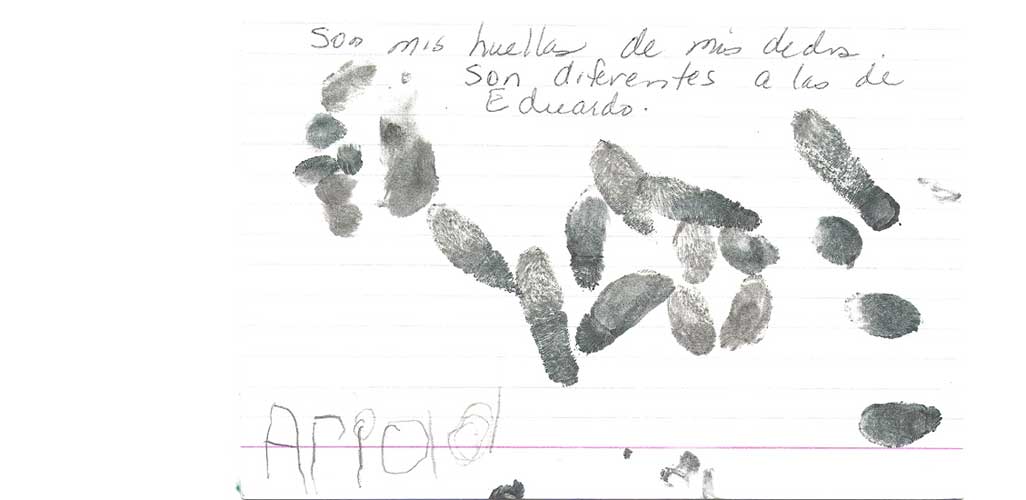
Figure 57. Larissa compared her fingerprints with Ricardo’s.
Benchmark 12.C.EC : Make comparisons among objects that have been observed.
Pharmacy
Children used the kitchen furniture in the dramatic play area as the pharmacy to store their hospital supplies and medicine. Nurses looked for the medicine and other supplies that they needed at the pharmacy. They also pretended to sell medicine to the patients.
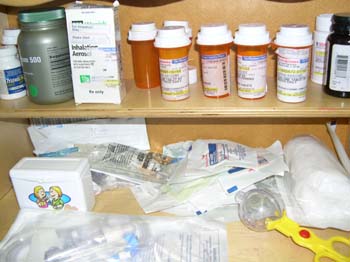
Figure 58. Hospital supplies and medicine stored in the dramatic play area. 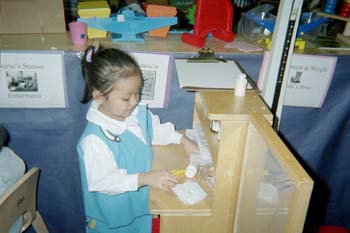
Figure 59. A doctor measures medicine. 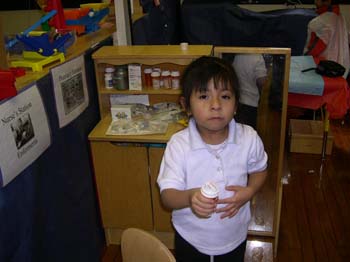
Figure 60. Nurse Ana getting medicine from the pharmacy.
Emergency Room
The block area was also used for transporting patients to the hospital. Children made an ambulance with blocks. They added drama to their game—they pretended to be paramedics or parents taking their child to the hospital:
Jonathan: Israel se puso malo y lo llevamos al doctor en la ambulancia. Yo le pongo suero y Alex le oye el corazón con el ‘escopio.’/Israel got sick and we took him to the emergency room. I put in an IV, and Alex listens to his heart with the ‘escopio.’

 Figures 61 & 62. The paramedics checking patient Israel.
Figures 61 & 62. The paramedics checking patient Israel.
State Goal 32: Demonstrate a respect and a responsibility for self and others.
Learning Standard B: Perform effectively as a member of a group.
Benchmark 28.A.EC: Maintain the native language for use in a variety of purposes.
Benchmark 30.A.EC: Use and maintain the native language in order to build upon and develop transferable language and literacy skills.
Emmanuel: Vamos para el hospital. Yo estoy enfermo. Me duele la cabeza y voy a ver al doctor. El doctor me va a picar y luego me da stickers./We are going to the hospital. I am sick. I have a headache, and I am going to see the doctor. The doctor is going to “prick me,” and then he will give me stickers.
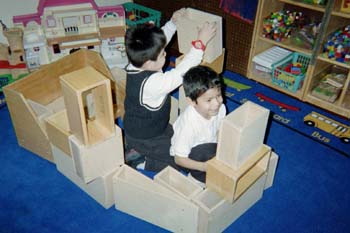
Figure 63. Sick children going to the hospital.
Miguel: Estamos poniendo un carro de ambulancia. Vamos al doctor./We are making an ambulance car; we are going to the doctor.
Benchmark 19.A.ECa: Engage in active play using gross motor skills.
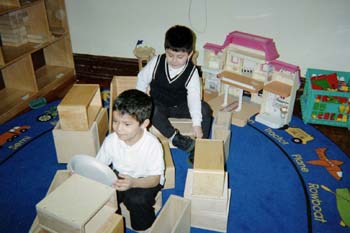
Figure 64. Children riding in an ambulance.
Sherley: Vamos a llevar la baby al doctor; ella está enferma./We are going to take the baby to the doctor; she is sick.”
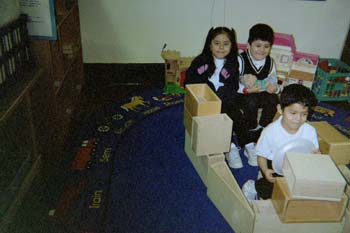
Figure 65. Children take a baby to the doctor.
Benchmark 26.A.ECb: Participate in drama activities.
Emmanuel: Mi mamá se pegó la mano y yo la curè. Yo soy el doctor y le doy medicina a mi mama./My mom hurt her hands and I healed it. I am the doctor and I give medicine to my mom.
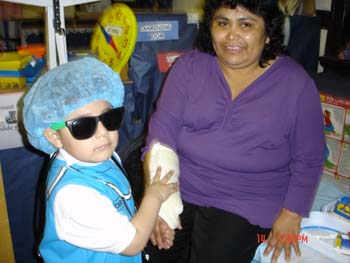
Figure 66. Doctor Emmanuel examines his mom.
Benchmark 15.A.EC: Identify community workers and the services they provide.
Benchmark 31.A.ECe: Show some initiative and independence in actions.
Parent Involvement
Parents are a very important component in our program. We see the parents of our children every day. It was easy to keep them informed about the project from the very beginning. I also sent a letter home to give parents ideas on how to support their children at home. Parents also were encouraged to talk with their children about their own experiences with doctors.
Many parents reported how much their child enjoyed participating in the project. Some parents came to visit Darwin Hospital to see their classroom doctors. Parents were amazed to see how their children looked and acted so professionally. They couldn’t believe that their children were able to act so naturally and with so much confidence as doctors, nurses, lab workers, pharmacists, and receptionists. Many of the children told their parents that they would be doctors when they grew up.
To involve the children’s parents, I organized a family activity. Children worked with their parents at home to make a display of pictures of their family. They could include pictures of the child in different stages of his/her development. They could include pictures or drawings, or they could cut pictures from magazines to add their favorite activities, toys, food, etc. Families were encouraged to get children involved in the process. When the display was ready, children took turns presenting their work to their friends in the classroom. Children presented their displays with one or both parents. Some children included pictures of healthy food in their display. They also shared with the group different exercises that they enjoyed doing at home that helped them to be healthy, such as walking, running, jumping, and bicycling.
When parents came to take part in the family activity, some children took the opportunity to invite their parents to our hospital to see them as doctors.
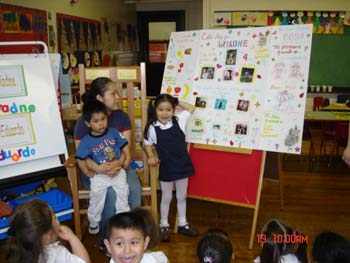
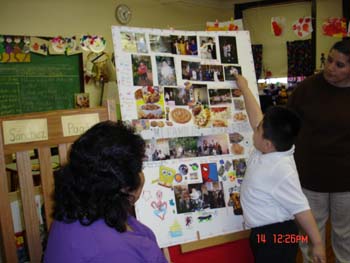
Figures 67 & 68. Parents and children prepared and shared family displays.
Benchmark 5.C.EC: Communicate information with others.
Phase 3: Concluding the Project
Assessing Children’s Knowledge
To find out how much the children learned about body parts and health, I asked them to trace each other and then had the children fill in their traced bodies. I wanted the children to identify body parts. I also showed the photographs that we had, so the children could retell me the story behind the pictures. I was amazed at the results.
The children traced each other’s bodies. The person that traced the body wrote his or her name plus the name of the other child. Each child then completed a body feature (Figures 69 & 70).
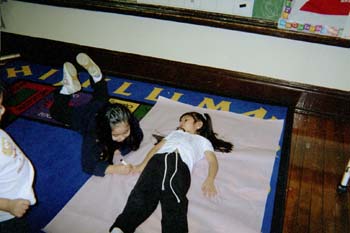
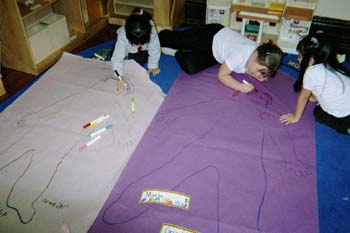
Figures 69 & 70. Rosa and Marisela (4 years old) traced their bodies.
Benchmark 23.A.EC: Identify body parts and their functions.
State Goal 23: Understand human body systems and factors that influence growth and development.
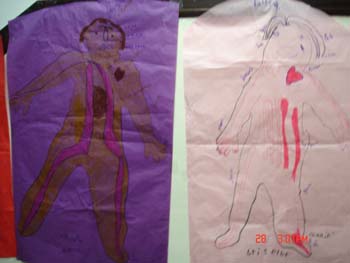 Figures 71-1 & 71-2. Rosa and Marisela identified some internal organs and the circulatory system.
Figures 71-1 & 71-2. Rosa and Marisela identified some internal organs and the circulatory system.
Rosa was able to identify some internal organs such as the heart, the stomach, and the circulatory system (Figure 71-1). Marisela was able to identify some internal organs such as the heart, stomach, and bones (Figure 71-2).
Benchmark 3.B.EC: Dictate stories and experiences.
Benchmark 31.A.ECc: Exhibit persistence and creativity in seeking solutions to problems.
Figure 72 shows a sign-in sheet that Madeline completed when she was acting as a receptionist on February 18, 2005. Figure 73 shows another sign-in sheet from Madeline on April 14, 2005. Her writing skills improved a lot. In Figure 73, she was able to write not only her name but her sisters’ name and some numbers. When she was writing on the sign-in sheet, instead of writing her friends’ names, she wrote her sisters’ because those are the names that she knows how to write.
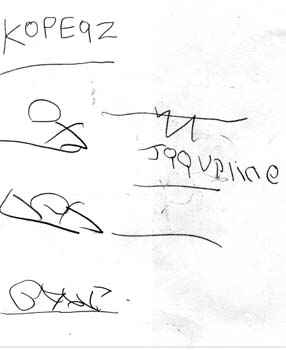
Figure 72. Madeline’s sheet on February 18, 2005. 
Figure 73. Madeline’s sheet on April 14, 2005.
Benchmark 3A.EC: Use scribbles, approximation of letters, or known letters to represent written language.
Figure 74 is a sample of Rosa’s writing on January 21, 2005, and Figure 75 is a sample on February 28, 2005. In the first one, she was able to write her name and some scribbles. In the second one, she wrote her name and drew a picture of a sphygmomanometer. She was able to copy the name in Spanish from a picture card.
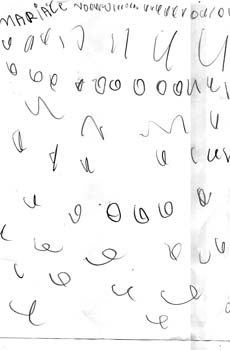
Figure 74. Rosa’s writing on January 21, 2005. 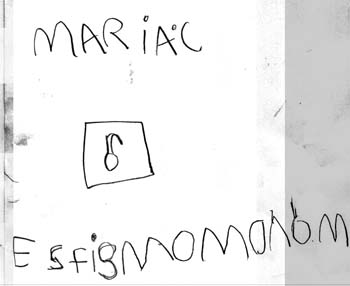
Figure 75. Rosa’s writing on February 28, 2005.
Benchmark 4.B.EC: Communicate needs, ideas and thoughts.
The differences between Emmanuel’s drawing on February 23, 2005 (Figure 76) and his drawing dated March 29, 2005 (Figure 77) are dramatic. Emmanuel described his second drawing: “He does not have feet. He cannot walk.”
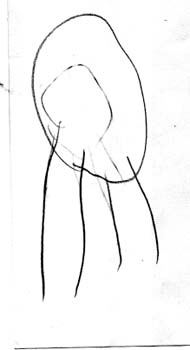
Figure 76. Emmanuel’s drawing on February 23, 2005. 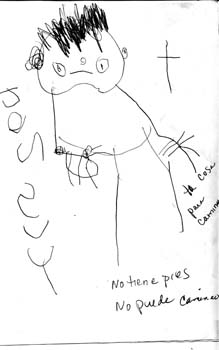
Figure 77. Emmanuel’s drawing on March 29, 2005.
Benchmark 25.B.EC: Describe or respond to their own creative work or the creative work of others.
Museum Display
This project lasted from January to April. I have never done anything in my classroom that lasted as long. Children were so excited playing hospital that it was difficult to see it end. After several months, there were still some students playing in the hospital. I did not know how to finish the project. However, since I was a part of the Early Childhood Connection Project, the Kohl Children’s Museum invited all the teachers that participated in the training for the Project Approach to display their projects in the museum. Parents were also invited to the museum for the exhibit and breakfast celebration. Children were excited to see a sample of their project in the museum.
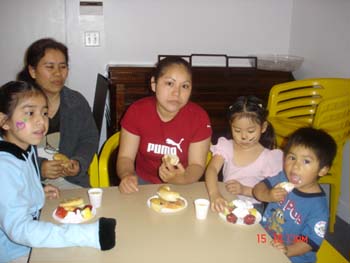
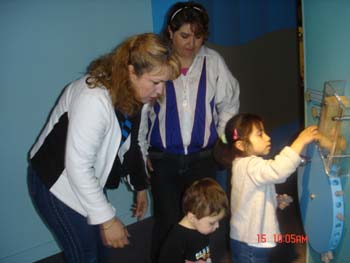 Figures 78 & 79. Parents at the museum.
Figures 78 & 79. Parents at the museum.
I also invited parents to come to the classroom to see the doctors and the different displays of children's work available around the room.
Eliah: I am a doctor. I’m looking at my mommy. She is sick.
Mrs. Sánchez: What are you using to check your mommy?
Eliah: I listen to the heart with this thing. I heard something. I told mommy she needs medicine. She has to go to the pharmacy.
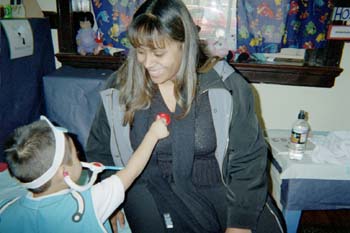
Figure 80. Dr. Eliah (3 years old) examining his mom.
Eliseo: Yo soy doctor y veo a mi mami. Me gusta ser doctor. A mi mami le duele la cabeza y luego le doy medecina. Estamos en el hospital. Estoy checando el brazo de mami con el mamoter./I am a doctor and I see my mommy. I like being a doctor. Mommy has a headache and I give her medicine. We are at the hospital checking my mommy's arm with the mamoter.
State Goal 31, Learning Standard A: Develop a positive self-concept. 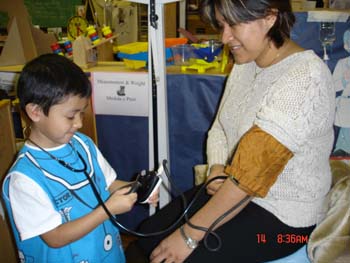
Figure 81. Dr. Eliseo examining his mom.
Teachers put together an album of pictures of children working on the project. Parents were very proud to see their children’s pictures in the albums. We also placed a display outside the principal’s office. Everyone was amazed by all the learning that took place while the children worked on this project.

Figure 82. Teachers put together an album of pictures of children working on the project. 
Figure 83. Some parents came to see the display of the Hospital Project. 
Figure 84. The project display outside the principal’s office.
Teacher Evaluation of the Project
The Hospital Project was a great learning experience for everyone involved. The children learned a lot about hospitals, nutrition, and their bodies. Their vocabulary increased as a result of this project. They learned to recognize the tools that doctors use and the reason they use them. The children learned to take turns, work together, and use materials appropriately. They increased their awareness of the different parts of their bodies. Many of the children were able to identify some internal organs and their functions. They also began to learn about the different food categories.
The most important thing the children gained from this project was self-confidence. They felt good about what they were doing and about themselves. People who came to our “hospital” noticed the children’s confident behavior and commented about it. Visitors were surprised to see the way children acted so naturally with tools and pretend situations.
The children also gained social skills. They learned to cooperate and developed patience as a result of understanding the roles they played in the hospital. If they wanted a turn to play the doctor, they were able to do other things while waiting for their turn. Many times, their turn was not even the same day, but the children evidently valued the experience enough to wait. I learned that when children have the freedom to choose the topic that they want to learn about, they have more opportunities to expand their knowledge and interact with one another in meaningful ways.
I saw that when children are interested, they can tackle a topic as difficult as anatomy. I gave the children a mini anatomy lesson using an anatomy model that I borrowed from the science teacher. I did not plan to do that. When I showed the anatomy model to children, they were amazed to discover that we have something inside of our bodies that we cannot see. After children had a lot of time manipulating the materials and playing doctor, I asked them to trace another child’s body, and then each student had to complete the different parts of his/her body. I did not tell them what to draw. The children amazed me when they completed their bodies. Many had drawn the stomach, bones, and heart, and one child even drew the circulatory system. I never expected them to be able to do that!
Children with special needs were included in the different activities with some modification when needed. In our dual-language English and Spanish program, I was pleased with the way that the children’s vocabulary increased in both languages. There was great interaction among all the students. Children were completely included, and there was a sense of pride and companionship. When children did not want to play in the hospital area, there were other activities that they were able to do.
With my next project, I will allow the children to make more decisions. I would not make any decision about the project without consulting them first. For example, during this project, I invited people from the school to visit our “hospital.” I should have asked the children and seen whether they had ideas on how to advertise our hospital to the public. For the culminating activity, I also made the decisions with my assistant instead of allowing children to give their opinions. I did not think about it until the project was over and I was reflecting on it. Teachers are used to making decisions based on our knowledge and experience, and many times we do not realize that children are capable of making good decisions if we allow them to do so. If we do this project again, I will make arrangements to invite a paramedic as an expert to give children the opportunity to see an ambulance and learn more about it. Another thing that I would do is to let the children listen to each other’s hearts before and after exercise so they could see the difference in heartbeats. Students will be able to notice the heartbeats before exercise and predict how the heartbeats change after exercise. I will also be able to ask more high-order thinking skills questions such as, “Why does our heart beat faster when we exercise?” “What happens if our heart beats fast all the time?” “What can we do to slow it down?”
This project showed me the value of doing a curriculum project based on children’s interests. The students were highly motivated for a long period of time. The project promoted extensive sociodramatic play with high levels of conversation, drawing, and writing. Children with limited vocabulary at the beginning of the project were more fluent at the end. Writing skills also improved. Children who were reluctant to write or draw pictures were highly motivated to do so because of their involvement in the hospital. For example, before participating in the project, Emmanuel had to be called several times to the writing center to write or dictate stories to me. Many times he was reluctant to work with us during writing activities. When he worked in the hospital, I did not have to encourage him to write; he was doing it voluntarily. Figures 76-77 show his writing skills at the beginning of the project and close to the end of the project.
This project was appropriate, meaningful, and relevant to the lives of the children. All the concerns that I had at the beginning of the project were resolved at the end. We accomplished more than we expected. Children gained knowledge and experiences across the curriculum, as we can see through all the samples of conversations and students’ work included in this article. Appendix 2 (PDF) shows a completed conceptual map at the end of the project.
Parents Comments
“I enjoyed seeing that preschool students are very creative and quick learners. My son was a doctor during this activity, and he was completely engaged, considering that he was 3 years old. My experience in this activity was wonderful. The nurse took my vitals, then the doctor (my son) examined me, and he prescribed some medication. He loved this activity so much that every chance he had in the classroom he would go to that area to play doctor. He did not want to do any other role but doctor. This experience has impacted him so much, until this day he says he wants to be a doctor when he grows up.”
“I felt so proud to see my son playing doctor with the group, taking into consideration that he has Down Syndrome. To see him engaged with others students and playing doctor was very satisfactory for me.”
Acknowledgments
I am thankful to Dr. Judy Harris Helm and the Kohl Children’s Museum for allowing me to participate in the Early Childhood Connections Project. I learned so much from them and I am very grateful. I also want to thank Dr. Lilian Katz for her comments and support and the opportunity to share our project with others. I also want to thank our parents and the school personnel who were involved in the project, especially our principal, Mrs. Graciela Shelly; our assistant principal, Mrs. Caryn Kaufman; and my assistant, Mrs. Carmen Pagán. Without their support, we couldn't be successful. I am especially grateful to Gloria Arango, Paz Martínez, Marta Moya and Kris Richardson for their helping hands and support.
Author Information
Xiomara Sánchez is a preschool teacher in a dual-language program at Darwin Elementary School in Chicago. She obtained her master’s degree in early childhood education from Roosevelt University in Chicago. She is also a National Board-certified teacher in early childhood education. Mrs. Sanchez has been teaching at Darwin Elementary for 12 years.
Xiomara Sánchez
Darwin Elementary School
3116 W. Belden
Chicago, IL 60647
Email: xasanchez@cps.k12.il.us
xiomaraabc@yahoo.com
Appendix 1
Goals, Standards, and Benchmarks Addressed during the Project
Language Arts
Speaking
The children shared their experiences related to visits to the doctor, dictated stories, communicated with friends, participated in drama, and asked questions to find answers.
- 1.C.ECa: Retell information from a story.
- 1.C.ECb: Respond to simple questions about reading material.
- 3.B.EC: Dictate stories and experiences.
- 4.B.EC: Communicate needs, ideas and thoughts.
- 5.B.EC: Relate prior knowledge to new information.
- 5.C.EC: Communicate information with others.
- 28.A.EC: Maintain the native language for use in a variety of purposes.
- 30.A.EC: Use and maintain the native language in order to build upon and develop transferable language and literacy skills.
Listening
The children identified sounds in the environment, such as an ambulance and fire truck. They also listened during conversations and followed directions.
- 4.A.EC: Listen with understanding and respond to directions and conversations.
Writing
The children wrote in journals, made prescriptions, drew, kept patients' records, and used sign-in sheets.
- State Goal 3: Write to communicate for a variety of purposes.
- 3.A.EC: Use scribbles, approximations of letters, or known letters to represent written language.
- 3.B.EC: Dictate stories and experiences.
- 3.C.EC: Use drawing and writing skills to convey meaning and information.
- 5.C.EC: Communicate information with others.
Reading
A variety of health-related books were provided for children to explore on their own. The children read records, doctors' orders, prescriptions, etc.
- 1.A.ECa: Understand that pictures and symbols have meaning and that print carries a message.
- 2.B.EC: Show independent interest in reading-related activities.
- 5.A.EC: Seek answers to questions through active exploration.
Social Science
The children investigated health career workers. They shared their experiences with them, showed pictures, and talked about what health care workers do.
- 15.A.EC: Identify community workers and the services they provide.
- 16.A.EC: Recall information about the immediate past.
Social/Emotional Development
The children talked about how people feel when they are sick versus when they are healthy. They showed empathy, acted responsibly, cooperated, took turns, and helped others.
- State Goal 31: Learning Standard A. Develop a positive self-concept.
- 31.A.ECb: Exhibit eagerness and curiosity as a learner.
- 31.A.ECc: Exhibit persistence and creativity in seeking solutions to problems.
- 31.A.ECe: Show some initiative and independence in actions.
- State Goal 32: Demonstrate a respect and a responsibility for self and others.
- Learning Standard B: Perform effectively as a member of a group.
Mathematics
The children measured height and weight, used the scale, measured things using different tools, conducted a survey of favorite food, collected data, and made graphs.
- 6.A.ECa: Use concepts that include number recognition, counting and one-to-one correspondence.
Physical Development and Health
The children exercised, moved their bodies according to musical rhythms, played Musical Chairs, and played Simon Says using commands to identify body parts.
- 19.A.ECa: Engage in active play using gross motor skills.
- 19.A.ECb: Engage in active play using fine motor skills.
- 19.C.EC: Follow simple safety rules while participating in activities.
- State Goal 23: Understand human body systems and factors that influence growth and development.
- 23.A.EC: Identify body parts and their functions.
Fine Arts
Drama
The children participated in dramatic play in the Darwin Hospital setting, including the lab, pharmacy, X-ray, waiting room, and examining room. They pretended to be doctors and nurses working with real patients.
- 26.A.ECb: Participate in drama activities.
Visual Arts
The children made observational drawings, body tracings, finger paintings, cotton swab paintings, and eyedropper paintings.
- 25.A.ECd: Visual Arts: Investigate the elements of visual arts.
- 25. B.EC: Describe or respond to their own creative work or the creative work of others.
Science
Tools that doctors use were available for children to explore: thermometer, cast, stethoscope, sphygmomanometer, skeleton, X-ray, etc. The children also studied fingerprints and parts of the body.
- State Goal 11: Understand the processes of scientific inquiry and technological design to investigate questions, conduct experiments and solve problems.
- State Goal 11, Learning Standard A: Know and apply the concepts, principles and processes of scientific inquiry.
- 11.A.ECa: Use senses to explore and to observe materials and natural phenomena.
- 11.A.ECb: Collect, describe and record information.
- 11.B.ECa: Use scientific tools such as thermometers, balance scales and magnifying glasses for investigation.
- 12.C.EC: Make comparisons among objects that have been observed.
- 13.B.ECa: Express wonder and ask questions about their world.
- 13.B.ECb: Begin to be aware of technology and how it affects their lives.
Appendix 2
Hospital Project Web Completion
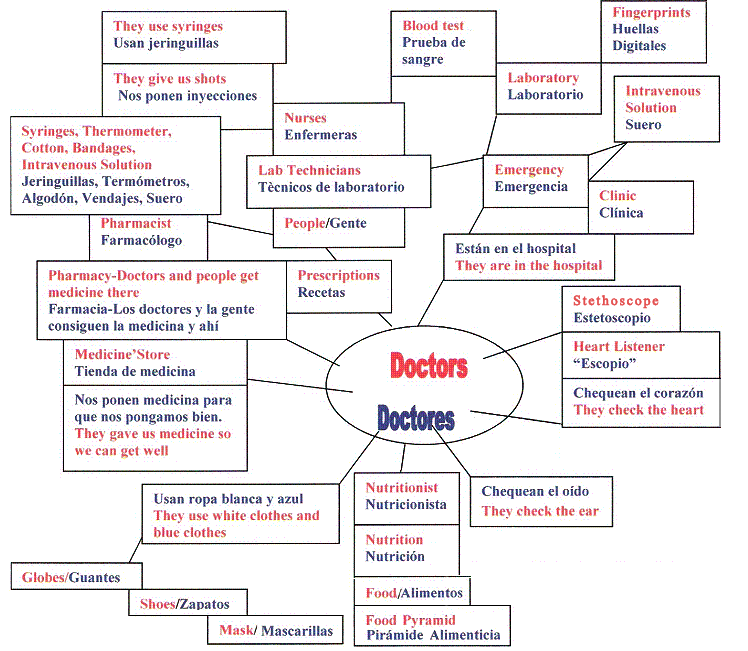
Appendix 2 shows a completed conceptual map at the end of the project.

